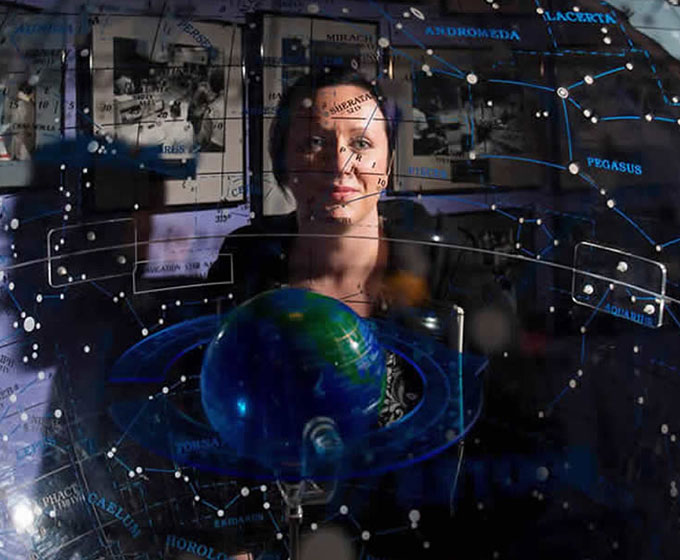
MAY 31, 2022 — Angela Speck, professor and chair in the UTSA Department of Physics and Astronomy, is looking to the stars, or rather stardust, for answers that are critical to addressing climate change.
Speck studies the material ejected by dying stars. Stars, she explains, are a lot like people. They have lives. They’re born, they live and they die. She sees opportunities in the dust particles that the stars eject at their death.
Understanding the composition of the dust that stars eject is vital in understanding the effect that dust has in both the galactic environment and Earth’s environment. Elements including carbon, nitrogen and oxygen that dominate living things are created inside stars. They get ejected into space as stars die.
“Assuming you just bury a body into the ground, the material that leaves the body leeches into the soil and fertilizes it,” said Speck. “Think about stars. As they die, the material that was made inside them is being thrown out into space and is fertilizing space.”
In addition to demystifying space, Speck’s research has implications for fields down on Earth. Stardust research, she explains, feeds into studies involving volcanoes. The dust emitted from a volcanic eruption shares a similar composition to the dust ejected from dying stars. She asserts that both offer a potential remedy to the earth’s increasing temperature.
“One of the theories out there for how we can combat climate change is by injecting small dust particles into the stratosphere,” she said.
Speck notes the 1991 eruption of Mount Pinatubo in the Philippines as an example. The global temperature dropped following the eruption due to volcanic dust.
According to NASA, scientists measured a decrease in the global temperature of about one degree Fahrenheit over the course of 15 months. They believe the temperature drop was due to dust particles that reflected light from the sun.
“So much dust from the volcanic ash was thrown up into the stratosphere and reflected light. The light never got down to the ground, so we cooled. My research allows us to test out some of those ideas about how dust really interacts with light in a big way by looking out in space,” Speck said.
How much the dust reduces the temperature, however, depends on its properties. The size, shape and composition of dust particles determine how reflective each grain is and how much cooling potential the dust offers.
“We study a lot of different things. There’s a lot of things people do not know about what it means to study astronomy,” said Speck. “It’s not just how planets move; it’s how light works, how nuclear physics works because that’s how stars are fueled. There are so many different directions you can go in.”
UTSA is a Tier One research university and a Hispanic Serving Institution specializing in cyber, health, fundamental futures, and social-economic transformation. UTSA aspires to become a model for student success, a great public research university, and an exemplar for strategic growth and innovative excellence.
UTSA Today is produced by University Communications and Marketing, the official news source of The University of Texas at San Antonio. Send your feedback to news@utsa.edu. Keep up-to-date on UTSA news by visiting UTSA Today. Connect with UTSA online at Facebook, Twitter, Youtube and Instagram.
Move In To COLFA is strongly recommended for new students in COLFA. It gives you the chance to learn about the Student Success Center, campus resources and meet new friends!
Academic Classroom: Lecture Hall (MH 2.01.10,) McKinney Humanities BldgWe invite you to join us for Birds Up! Downtown, an exciting welcome back event designed to connect students with the different departments at the Downtown Campus. Students will have the opportunity to learn about some of the departments on campus, gain access to different resources, and collect some giveaways!
Bill Miller PlazaCome and celebrate this year's homecoming at the Downtown Campus with food, games, giveaways, music, and more. We look forward to seeing your Roadrunner Spirit!
Bill Miller PlazaThe University of Texas at San Antonio is dedicated to the advancement of knowledge through research and discovery, teaching and learning, community engagement and public service. As an institution of access and excellence, UTSA embraces multicultural traditions and serves as a center for intellectual and creative resources as well as a catalyst for socioeconomic development and the commercialization of intellectual property - for Texas, the nation and the world.
To be a premier public research university, providing access to educational excellence and preparing citizen leaders for the global environment.
We encourage an environment of dialogue and discovery, where integrity, excellence, respect, collaboration and innovation are fostered.